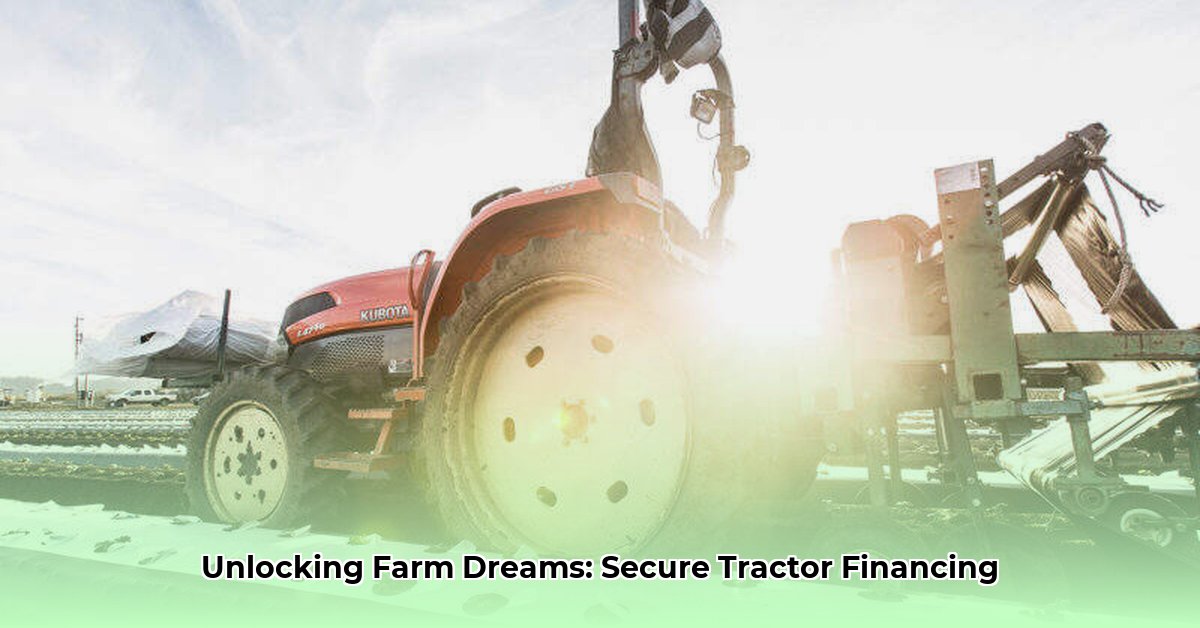
Buying a used tractor is a smart financial move for many farmers, boosting efficiency without breaking the bank. But securing the necessary financing can feel like navigating a maze. This guide provides a clear path, helping you obtain the loan you need for sustainable agricultural practices. We'll cover everything from understanding loan types to negotiating the best terms. Let's get you the equipment you need—responsibly. For more information on rates, check out our tractor loan rates.
Exploring Your Tractor Financing Options
Several loan types can finance your used tractor purchase. Choosing the right one depends on your specific needs and financial situation. Here's what you need to know:
Equipment Loans: Specifically designed for purchasing farm equipment like tractors, these loans often feature competitive interest rates and repayment schedules tailored to the agricultural cycle. This is usually the most straightforward option for used tractor purchases.
Operating Loans: These loans cover general farm expenses. While potentially usable for a tractor, they might have higher interest rates than equipment-specific loans. Consider this if you need funding for multiple expenses concurrently.
SBA Loans (Small Business Administration): The SBA offers loans that can be used for equipment, including used tractors. They are known for longer repayment periods and potentially lower down payments, but the application process requires more extensive documentation. Good for farmers needing longer repayment periods.
Farm Credit Unions: These credit unions specialize in agricultural lending. They often offer more favorable terms and understanding of agricultural finances compared to traditional banks. A strong choice for farmers in agricultural communities.
Local Banks: Don't dismiss your local bank. Existing relationships can be a significant asset, and some offer programs tailored to agricultural needs. Building a strong banking relationship is long-term beneficial.
Choosing the Right Lender for Your Needs
Selecting the right lender is crucial. Each type has unique advantages and disadvantages:
| Lender Type | Advantages | Disadvantages |
|---|---|---|
| Banks | Established institutions, larger loan amounts possible | Stricter eligibility criteria, more formal application processes |
| Credit Unions | Member-owned, personalized service, potentially higher approval rates | May have lower loan limits compared to banks |
| Online Lenders | Convenience, quick pre-approvals | Potentially higher interest rates, less personal interaction |
| Farm Credit Unions | Specialized knowledge of agriculture, potentially more lenient criteria | May have limited geographic reach |
Careful consideration of your specific financial circumstances is key when selecting a lender. Do your research!
Inspecting Your Potential Tractor Purchase
Before applying, thoroughly inspect the used tractor. This protects your investment and strengthens your application.
Age and Hours: Newer tractors with fewer operating hours generally have better resale value and reduce loan risk. This is a key factor for lenders.
Maintenance Records: Comprehensive maintenance logs demonstrate responsible ownership and a well-maintained tractor, reducing the risk of future repairs and appealing to lenders.
Professional Inspection: A pre-purchase inspection by a qualified mechanic is highly recommended. This provides you with valuable information and gives your loan application extra credibility.
A thorough inspection reduces your risk and improves your chances of loan approval.
Step-by-Step Guide to the Loan Application
The loan application process typically follows these steps:
Step 1: Gather Your Documents. Compile essential financial documents, including income statements, credit reports, and tax returns. A complete application with strong financials increases approval chances.
Step 2: Shop Around. Research multiple lenders to compare interest rates, repayment terms, and any special programs. Getting multiple quotes is crucial.
Step 3: Complete the Application. Fill out the application accurately and thoroughly. Errors can delay or prevent approval. Attention to detail is key.
Step 4: Negotiate Terms. Don't hesitate to negotiate interest rates and payment schedules. A larger down payment will often secure better terms.
Step 5: Review & Sign. Carefully review the loan agreement before signing. Understand the terms and conditions fully. This is a legally binding document.
Long-Term Financial Planning
Securing a loan is only the first step. Effective financial planning is vital for long-term success:
Create a Budget: Develop a detailed budget that includes loan repayments, operating costs, maintenance, and potential repair expenses. This helps you stay on track.
Monitor Finances: Regularly monitor your income and expenses to ensure you're meeting your financial obligations and that your farm remains profitable. Regular monitoring is crucial.
Explore Additional Funding: Consider grants or subsidies that support sustainable agricultural practices. This can supplement your loan funding.
Responsible financial management ensures the long-term success of your farming operations. Careful planning minimizes risk.
Conclusion
Securing a loan for a used tractor is an investment in your farm's future. By following this guide and planning carefully, you can increase your chances of approval and build a thriving sustainable operation. Remember to actively work with the lender – your proactive approach will be valued.